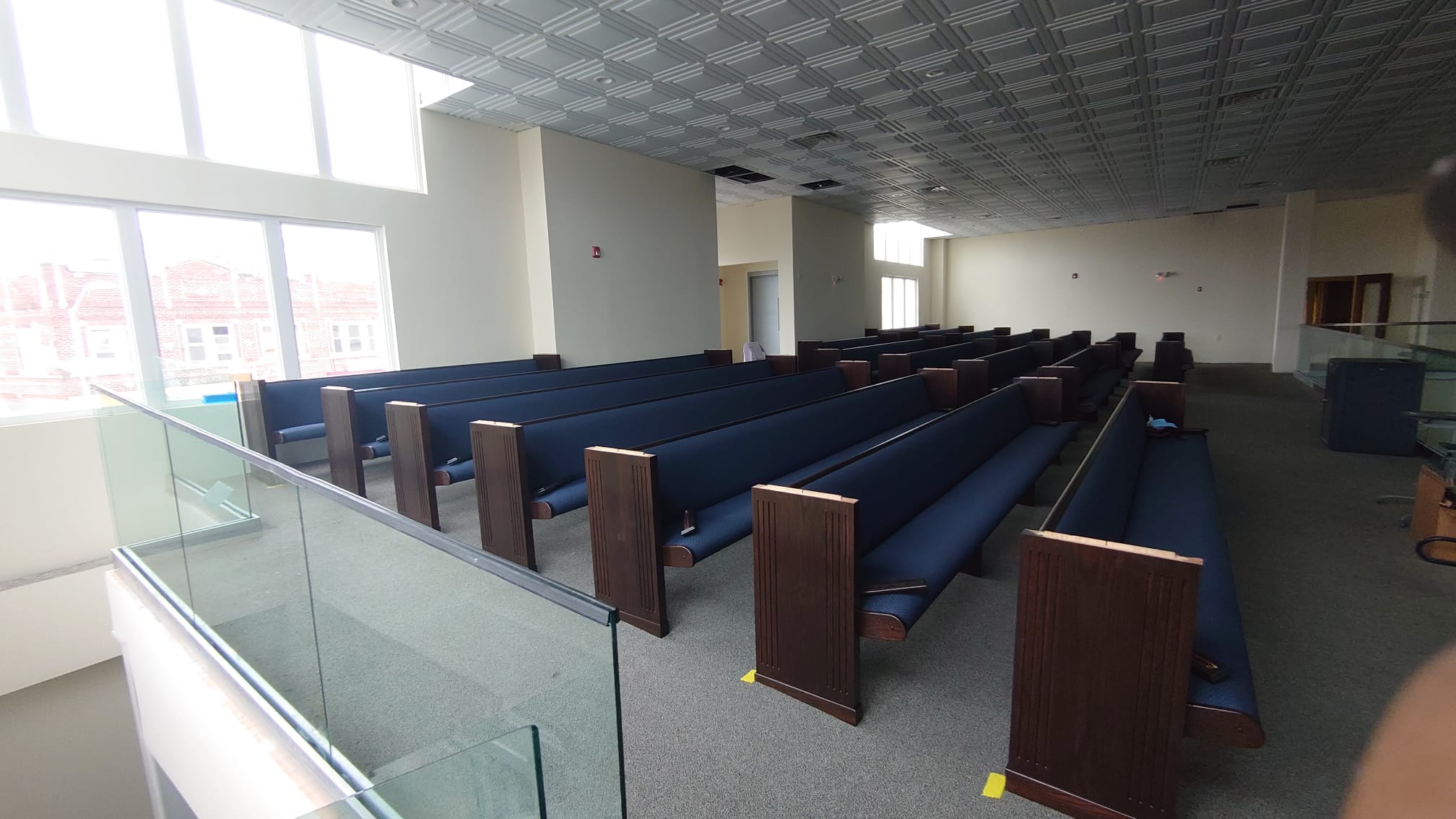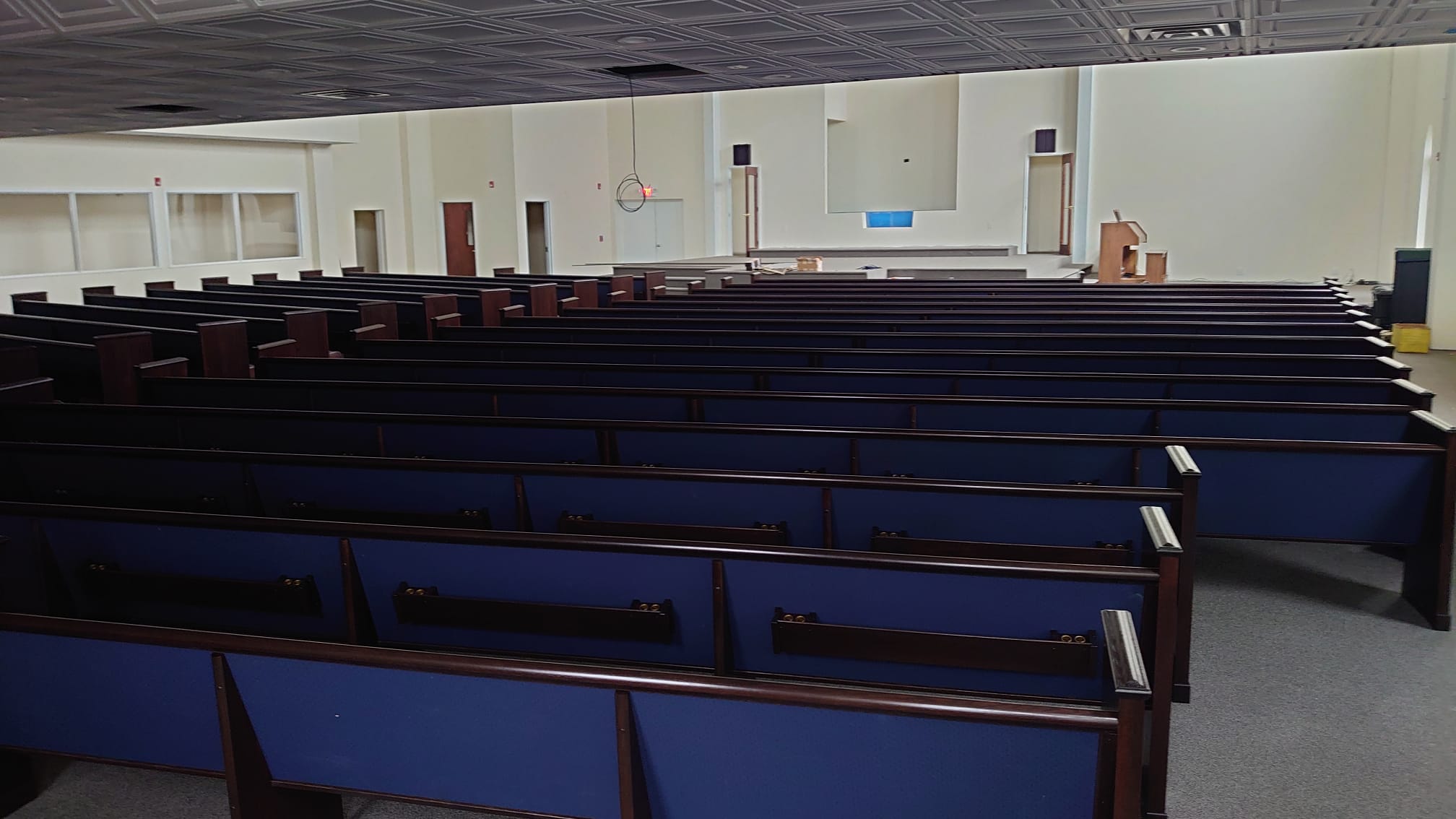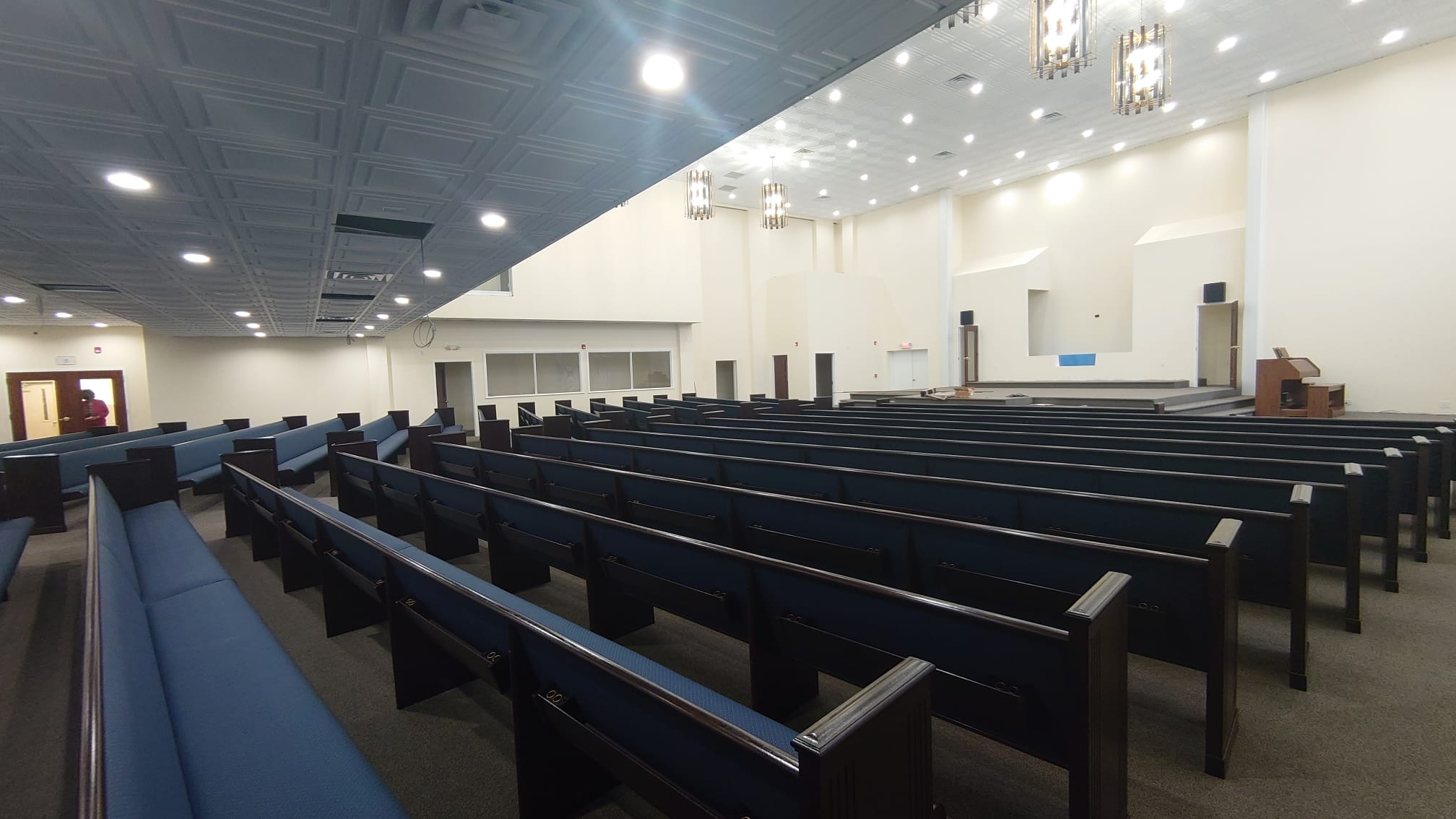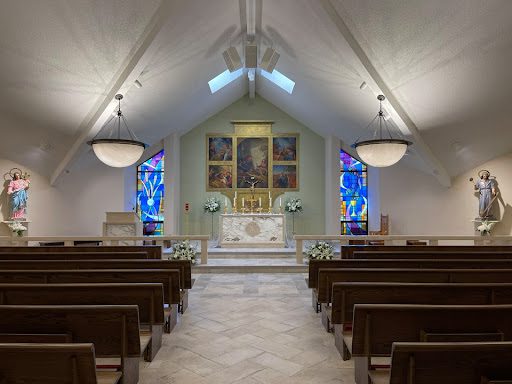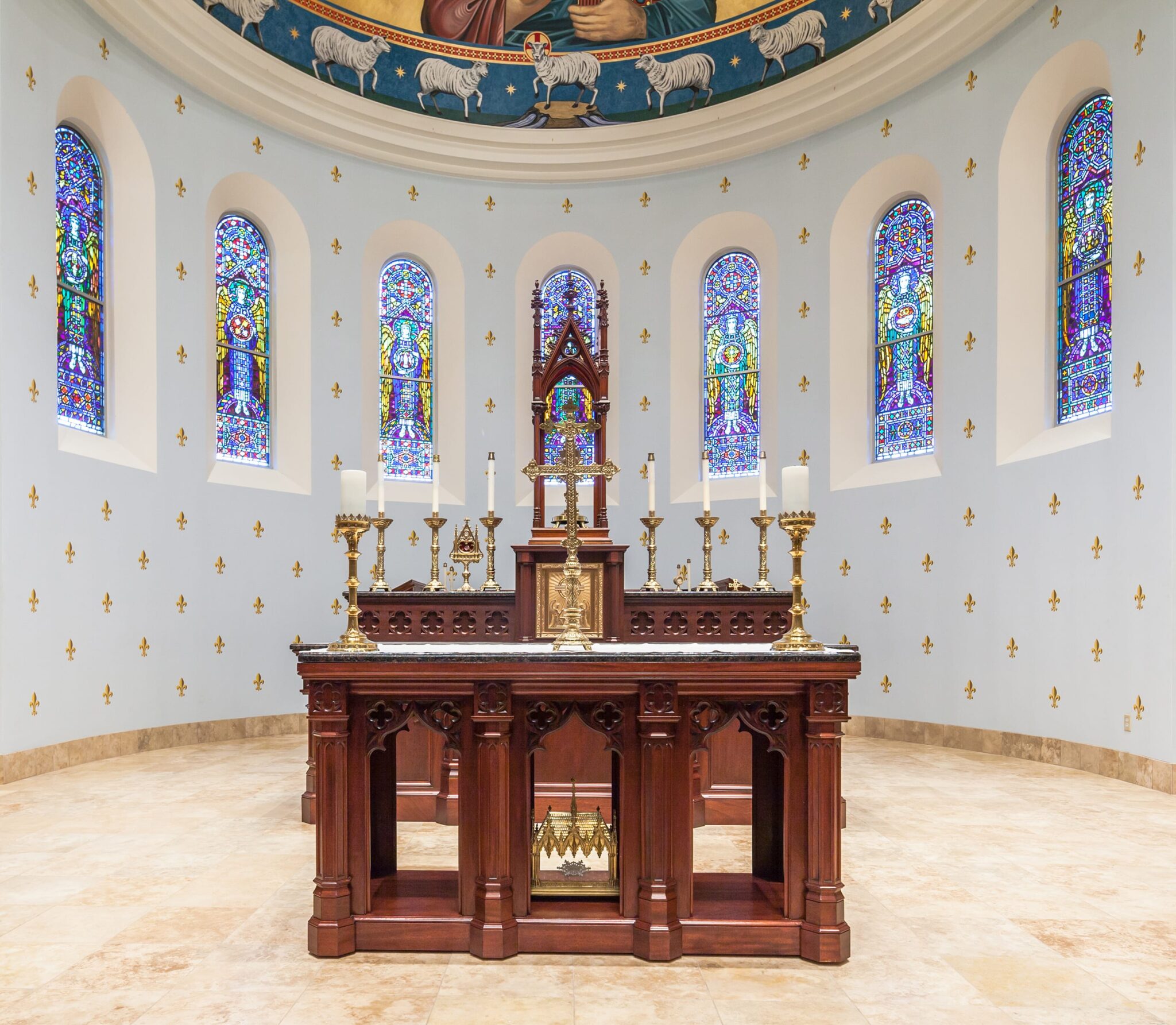
When it’s time to renovate or redesign your church or synagogue, you likely focus on your seating options. Whether it’s radius curved pews, straight pews, or church chairs, you want high-quality, long-lasting church and synagogue furniture. But what about other aspects of your sanctuary?
In today’s blog post, we will look at a feature in your worship space that you might overlook: Altar Tables and other types of tables used in worship services. Enhancing your place of worship with the right altar table can elevate the spiritual experience for your congregation. From the functional Credence Table to the symbolic Altar Table, each piece serves a unique purpose in different denominations. Many houses of worship have tables strategically placed around the worship space that often hold candles, collection plates, and holy books.
Here at New Holland Church Furniture, we handcraft our quality-built worship furniture with your specific church, parish, or synagogue in mind. For over 70 years, our master craftsmen have built beautiful furniture pieces for worship spaces all over the Western Hemisphere that are a source of pride for congregations.
Continue reading to learn more about the various worship tables and their uses for each religion. When it’s time to upgrade the tables in your worship space, contact the New Holland Church Furniture experts! We’ll guide you through the design and build process to ensure you get the right tables for your church or synagogue. Give us a call or find a rep in your area to get started today!
Why Are Altar Tables so Important?
Altar tables are more than just furniture in a place of worship. They are the focal point of spiritual activities. In both churches and synagogues, the altar serves as a sacred spot where rituals and ceremonies are performed. It’s where the congregation directs their focus during services, making the altar table a crucial element in setting the tone for worship.
For Christians, the altar is where the sacraments are administered, symbolizing the presence of Christ during the Eucharist. In Jewish traditions, the Torah Reading Table is central to the practice of reading from the Torah, reinforcing the importance of scripture in worship. Selecting the right altar table means respecting the tradition and function it upholds, ensuring that the spiritual significance is reflected in the design and placement of the table within the worship space.
What Role Do Altar Tables Play in Different Religions?
Altar tables play a significant role in the worship practices of various religions, each with its unique traditions.
- Christianity – In Christianity, the altar is central to many denominations for the celebration of the Eucharist or Holy Communion. It’s a symbol of Christ and serves as a place for sacrifice and forgiveness.
- Catholicism – Catholic churches often feature elaborate altar tables that hold relics and are used for the consecration of the bread and wine.
- Protestantism – In Protestant churches, the altar may be simpler, focusing on the sermon and the word of God.
- Judaism – Meanwhile, in Judaism, the Torah Reading Table is not just a physical stand but a platform for honoring the Torah. It’s used during services when the Torah scroll is read, playing a vital part in Jewish religious life.
Each of these tables, regardless of religion, is crafted with care to inspire reverence and support the sacred rituals they host when made by the New Holland Church Furniture artisans. Next, we’ll look at the six specific types of tables you may find in a church, cathedral, or synagogue.
1. Credence Table
If your house of worship belongs to the Protestant faith, there are several styles of tables that perform various functions. For example, a Credence Table is a small table on the south side of the sanctuary. Many churches use this table to display the tools used during the Communion ceremony. These tools can be a bowl, perforated spoon, ewer, towel, and the wine and bread used for the service.
This table may be simple or ornate, but always crafted to blend seamlessly with the church’s aesthetics. The design is intentional, often made of wood that reflects durability and tradition, symbolizing the steadfastness of faith.
The Credence Table is more than just a practical surface. It’s a part of the sacred architecture of the church. It supports the liturgy by ensuring that the bread and wine are treated with the reverence they deserve. For many congregations, the presence of a Credence Table is essential, as it helps maintain order during the service and upholds the sanctity of the sacramental elements.
2. The Lord’s Table or Communion Table

The Lord’s Table, also known as the Communion Table, is a profound symbol of unity and fellowship in the Christian faith. It stands at the heart of the worship space, inviting believers to come together in remembrance of Jesus’ sacrifice. When it’s time for a church to perform a Communion Service, the tools are moved from the Credence Table to the Lord’s Table.
Also called the Communion Table, this table serves as the place where the bread and wine (or wafers and grape juice) are placed so that members of the congregation may receive them from their church leaders during a holy ceremony.
You’ll find communion ceremonies of varying types and frequencies in Liturgical, Catholic, and Protestant churches. This table may also be called an Altar Table. However, some church congregations, such as Methodists, do not use these tables as they do not perform a communion ceremony regularly.
The design of the Communion Table is often modest yet dignified, emphasizing the solemnity of the sacrament rather than the opulence of the furniture. It’s a place where all are equal, and the shared experience of communion fosters a sense of togetherness among the faithful. In selecting a Communion Table, churches consider both its spiritual significance and its ability to accommodate the needs of the congregation, ensuring that this central act of worship is carried out with respect and reverence.
3. The Holiness Table
The Holiness Table is a central piece of furniture in worship spaces, particularly within Methodist and other Holiness movement churches. Its presence highlights the importance of personal piety and the pursuit of a holy life. In some denominations, a Holiness Altar Table is placed at the front of a sanctuary. It was traditionally used as a significant focal point of the worship service, where congregants would stand, come to the Holiness Table, and receive a blessing.
Today, it is more often used as a display table. It may hold flowers, offering plates, or a large Bible. People may go to the Holiness Altar Table to read the Bible, pray, or seek a blessing. As with many houses of worship, the size of your space will determine how many worship tables you have and how they are used.
The Holiness Table’s design is usually unadorned and straightforward, reflecting the movement’s emphasis on simplicity and heartfelt worship. By serving as a visible reminder of the faith’s core values, the Holiness Table supports a worship environment where spiritual growth and holiness are nurtured. New Holland Church Furniture will work with you and your congregation to build new tables or upgrade the current look of your worship space to create an inviting and welcoming place for all who enter your doors.
4. The Offertory Table
In Catholic Churches, Holy Communion is offered during each Mass. The table used during the “Preparation of the Gifts” is called the Offertory Table. It’s part of a Roman Rite in which the Gift Bearers take the gifts of the bread or wafers and wine from the Offertory Table and process them up from the community to the priest.
A Credence Table is also used in the sanctuary of a Catholic church to hold these items before they are consecrated during the celebration of the Eucharist.
The design of the Offertory Table can vary from simple to ornate, but it consistently serves as a symbol of the generosity and participation of the parish community. The table’s presence reminds worshippers of their personal offerings, whether spiritual or material, as part of the communal celebration of the Mass. For many, the act of preparing the gifts on the Offertory Table is a significant part of the liturgy, representing the community’s shared devotion and commitment to their faith.
5. The Altar Table
The Altar Table is used similarly to the Communion Table. In the Catholic church, the altar is the table on which the holy sacrifice of the Mass is offered. An Altar Table can also serve other purposes. In Orthodox Churches, for example, the altar is an area at the east end of the church, usually behind an iconostasis (altar screen). The Altar Table is placed in the center and is sometimes referred to as the Holy Table. These tables are usually cube-shaped, covered with a cloth, and topped with a tabernacle and candle stands.
Its design and placement are carefully considered to reflect its sacred purpose and the architectural style of the worship space. In some traditions, the altar is adorned with cloths, candles, and other liturgical items, each with its own symbolic meaning. The versatility of the Altar Table lies in its ability to be adapted to the specific liturgical needs of a service or denomination. Whether it’s hosting the consecrated elements during the Eucharist, supporting a display of flowers, or providing space for a bible and cross, the Altar Table is a potent symbol of the divine presence in the midst of the community of believers.
6. Torah Reading Tables

You’ll frequently find Torah Reading Tables in synagogues, also called the Bimah, where the Rabbi stands. Torah Reading Tables are integral to Jewish worship, serving as the dedicated space for reading the Torah during services. Positioned centrally in the synagogue, these tables are often beautifully crafted to honor the sacredness of the Torah scrolls.
They come in various styles, but all are designed to hold the scrolls securely while allowing for the traditional rituals of reading and handling the Torah. The table’s surface is typically flat and smooth, facilitating the unrolling and rerolling of the scrolls.
In many synagogues, the reading table is also a focal point of the architecture, reflecting the importance of the Torah in Jewish life and tradition. It’s not just a piece of furniture. It’s a symbol of the Jewish commitment to study, understand, and live by the words of the Torah. As such, choosing the right Torah Reading Table is a matter of both functionality for the service and reverence for the tradition.
New Holland Church Furniture can make your Bimah furniture in any style to match your current look or help you find something new. We can even include pull-out steps for a Bar or Bat Mitzvah child to stand during an Aliyah when they read a portion of the Torah. As the leading manufacturer of custom worship furniture, we can create or upgrade any worship furniture piece for your synagogue. Get in touch with your local rep today.
Why Should We Order a Custom Altar Table?
Custom altar tables offer multiple benefits, allowing worship spaces to align their furniture with their unique spiritual and aesthetic needs. One significant advantage is the ability to tailor the size, style, and materials of the table to fit the specific dimensions and design of the worship area. Customization ensures that the altar table harmonizes with the existing architecture and decor, enhancing the overall ambiance of the space.
Moreover, a custom altar table can incorporate specific religious symbols and artwork, making it deeply personal and reflective of the congregation’s beliefs and values. Custom tables can be designed to be more functional, with considerations for storage, portability, or multi-use purposes, which is especially beneficial for growing congregations or those with versatile worship practices. Ultimately, a custom altar table is a crafted element that contributes to the sacred experience of worship.
How Do I Find the Perfect Altar Table for My Worship Space?
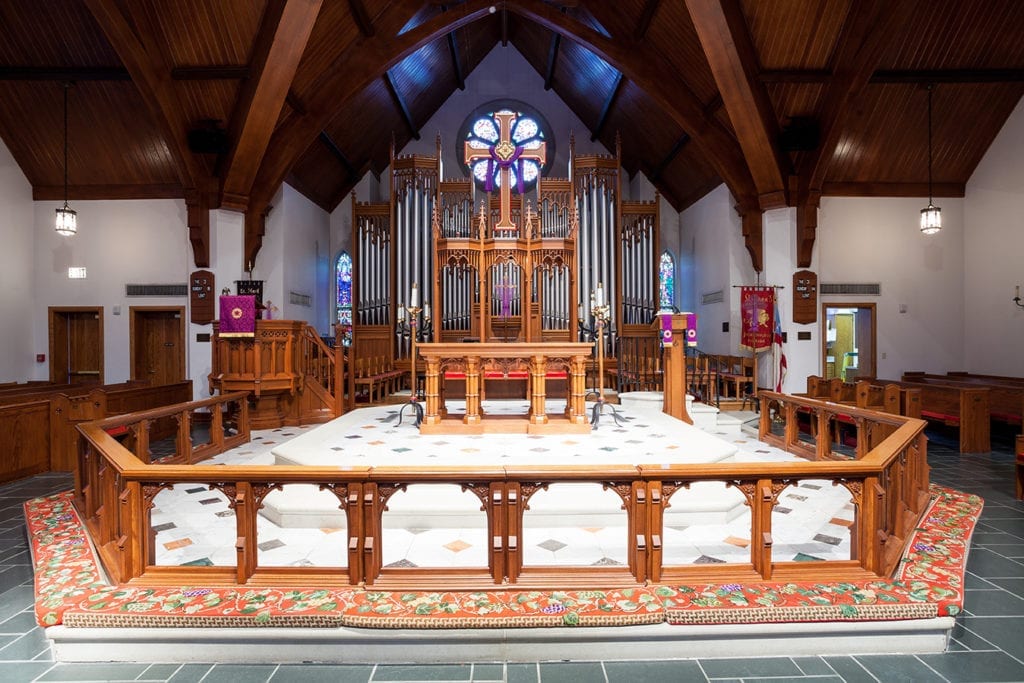
Selecting the perfect altar table for your worship space is a thoughtful process that involves considering both function and form. Start by assessing the specific needs of your congregation and the type of services you conduct. Think about the size of your space and how the table will fit within it. You’ll want to ensure that the table is neither too large to overwhelm the space nor too small to be noticed.
Pay attention to the materials and craftsmanship. A well-made altar table can last for generations, becoming a cherished part of your community’s heritage. Consider the style of your worship space and seek a table that complements it. Whether you prefer a classic look with intricate carvings or a modern design with clean lines, the right table should resonate with the spiritual atmosphere of your sanctuary.
Frequently Asked Questions About Altar Tables
As a leading manufacturer of worship furniture, we often get questions about worship tables and their uses. Here, we’ve listed some of the most common ones we get with a detailed answer. Don’t see your question listed? Just contact us for help!
What Is an Altar Table for?
An altar table serves as a sacred platform for religious rituals and ceremonies. Its primary purpose is to support the various elements used during worship, such as sacramental items in Christian services or the Torah scrolls in Jewish synagogues. The altar table is often the focal point of a religious service, where the congregation directs their attention and prayers.
In Christianity, it’s typically where the Eucharist is celebrated, symbolizing the Last Supper and the presence of Christ. In Jewish tradition, the reading of the Torah takes place at a specially designed table, emphasizing the significance of the scriptures. Additionally, altar tables can signify a place of sacrifice, remembrance, and divine communion. They are not just functional pieces but are imbued with profound spiritual and symbolic importance, reflecting the values and traditions of the faith community.
What Is the Difference Between an Altar and a Communion Table?
The terms ‘altar’ and ‘communion table’ are often used interchangeably, but there can be distinctions based on denomination and worship practices. An altar is traditionally considered a place of sacrifice and is central to many liturgical churches, including the Catholic, Eastern Orthodox, and Anglican traditions. It is used for the consecration of the Eucharist and may have a more ornate and permanent structure.
In contrast, a communion table is commonly found in Protestant churches where the focus is on the sacrament of Holy Communion as a commemorative event rather than a sacrificial one. It tends to be more straightforward in design and may be movable. The communion table is a symbol of the Last Supper and the unity of believers. These differences reflect the various theological interpretations and traditions within Christianity, each emphasizing the elements of their worship.
Why Do Some Churches Use a Table Instead of An Altar?
Some churches opt for a table instead of a traditional altar to reflect their theological beliefs and worship practices. In many Protestant denominations, such as Baptists or Methodists, the use of a table rather than an altar is intentional. It emphasizes the commemorative nature of the Lord’s Supper rather than the concept of sacrifice, which is often associated with altars.
The table signifies fellowship, unity, and the sharing of a meal, as Jesus did with his disciples. It’s a representation of the Last Supper and serves as a reminder of Jesus’ teachings about community and remembrance. This choice also aligns with a historical move away from the more ceremonial traditions of the Catholic Church during the Reformation, seeking simplicity and a return to the practices of the early Christian church. The table is a powerful symbol of these principles, focusing on the spiritual rather than the physical aspects of worship.
Where Should an Altar Table Be Placed?
The placement of an Altar Table is a considered decision deeply rooted in the customs and liturgical guidelines of the specific religious denomination. In Christian churches, the altar is typically positioned at the front of the sanctuary, often on a raised platform known as the chancel. This location allows the congregation to focus their attention on the altar during services and ceremonies.
In Catholic and Orthodox traditions, the altar is usually more central and may have additional elements like a tabernacle or sanctuary lamp indicating the divine presence. In Protestant churches, where the focus might be more on preaching the Word, the table may be placed closer to the congregation to emphasize the communal nature of worship.
In synagogues, the Torah Reading Table is centrally located to allow the congregation to gather around during the Torah reading, highlighting its importance. Each faith has specific traditions, but the common goal is to respect the sacredness of the altar table and its role in worship.
Examples of Church Altars and Synagogue Tables
Church altars and synagogue tables come in various designs, each embodying the traditions and aesthetics of their respective faiths. When you want an experienced manufacturer of such a table, you’ve come to the right place. Find inspiration for your Altar Table in some of our past work.
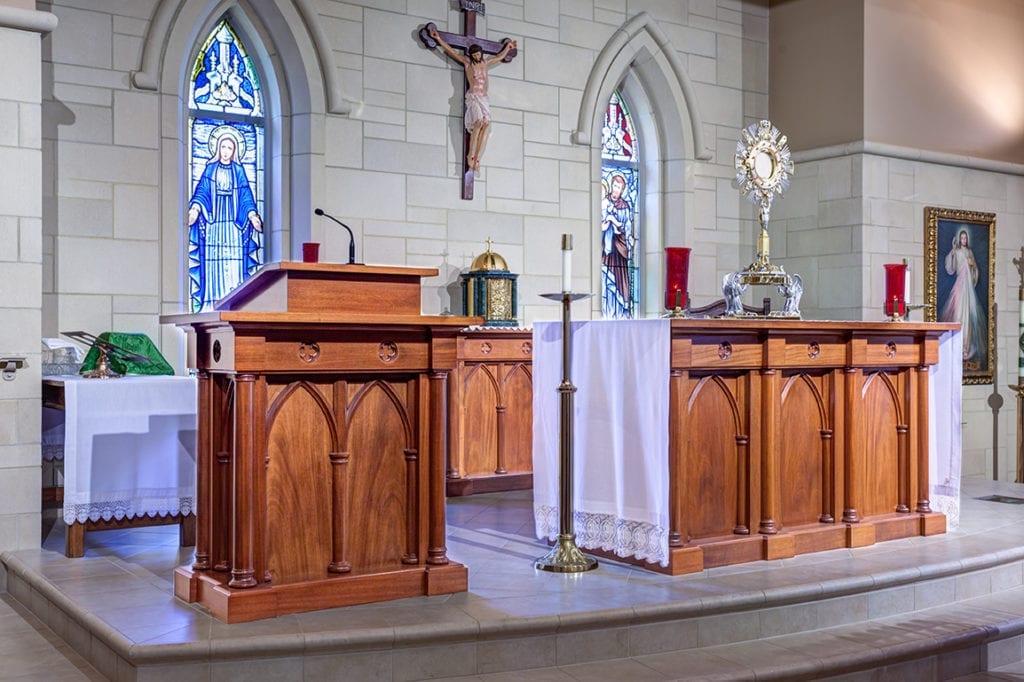
St. Peter Chanel Catholic Church – Roswell, GA

St. Louis King of France Catholic Ch. – Austin, TX
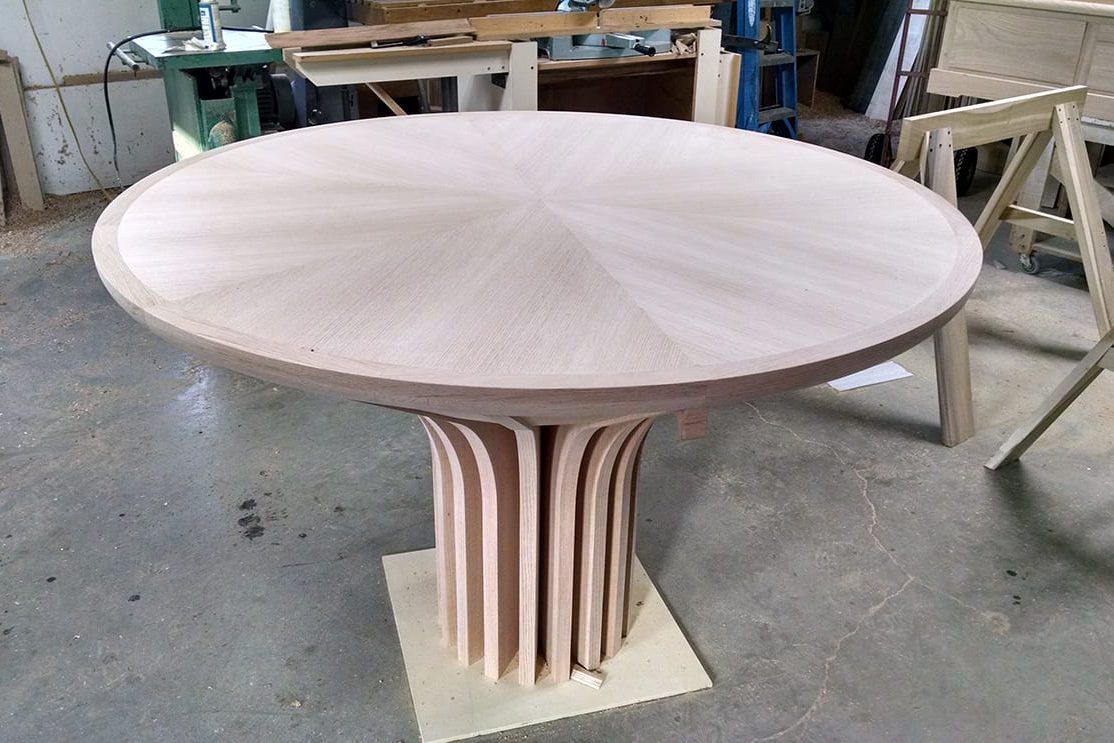
Congregation Kol Emeth – Palo Alto, CA
Get Custom Tables Designed for Your House of Worship
No matter what type of Altar Table your church wants, or Bimah stand your synagogue requires, New Holland Church Furniture is here to help! We can design and build custom Altars or Communion, Credence, Offertory, Holiness Tables, Torah Reading Stands, and more for you.
When it comes to selecting furniture for your place of worship, choosing New Holland Church Furniture means opting for quality, craftsmanship, and a deep understanding of your sacred space’s needs. Our reputation is built on providing worship tables that are not only aesthetically pleasing but also constructed to stand the test of time. With a wide variety of styles, from traditional to contemporary, and the option for complete customization, we ensure that each piece reflects the unique spirit of your congregation.
For over 70 years, we have been helping churches and synagogues reimagine and preserve the look and feel of their worship spaces. We’re located in New Holland, Pennsylvania, but we have served our customers worldwide. Give us a call or find a rep in your area to get started today!

